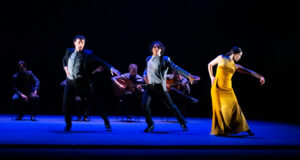Pros: Some novel approaches to presenting information from the huge amount of data generated by society.
Cons: Not all the pieces have something new or interesting to say. An interesting exhibition which covers a lot of ground in the topic of big data.
Summary
Rating
Good
Big Bang Data is an exhibition currently running at the beautiful Somerset House, just by Waterloo Bridge. It deals with the fascinating topic of the explosion through data generated and collected in the world in the last 50 years. The technological revolution brought about by the computer and the ever-decreasing size and cost of data storage has transformed the way we live our lives. From online shopping and the rise of social media, through to the scandals of secret data collection programmes (such as those denounced by Edward Snowden), there is much to say about how society interacts so called ‘big data’. This exhibition collects work from dozens of artists who seek to explore and make sense of some of the aspects of this broad topic.
Although you might not have expected this of a part-time theatre reviewer, I handle very large datasets as a day job. As a particle physicist, I am often confronted with some of the realities of ‘big data’. These realities include the fascinating, subtle things to be discovered in large datasets; that analysing this much data can be very tricky, and presenting it in a coherent way even more so; and finally, that huge swathes of data are totally uninteresting. My personal experience of working with data is what piqued my interest in the exhibition. I was very curious to know how artists might approach some of these challenges.
The exhibition was divided into sections each focusing on a different aspect of the ‘big data” age. A particular favourite was a section which approached the question of “where is this information physically?” This mapped the network of data centres and huge trans-oceanic cables which allow us to communicate instantly with people anywhere in the world, also showing how the cables had to evolve to handle ever-increasing bit rates. Other fascinating aspects involved trying to analyse some of the data collected in London in real time, based off twitter feeds and other social media sources, to discover how happy each London borough was feeling on that particular evening.
Some of the works were very light-hearted whilst others were stark reminders that we often share much more data than we intend or even realise. One example of this was a fascinating work by an artist who collected cigarette butts or gum off the streets, and was able to use the DNA samples to create realistic models of what smoker or chewer would have looked like. Naturally, the debate about data collection for security reasons came up, and we saw a short film about the Edward Snowden affair. But to counteract any such negative connotations of big data, there was also room for hope. We were able to learn much about many crowd-sourced movements which seek to use the huge amount of data available to try to improve the world around them.
Although I found much of the content of the exhibition interesting, I found few pieces that really blew my mind. My hope was that artists tackling the issues around big data would be able to provide insights that a researcher or analyst might miss. In the end, I don’t think I found this. I think the exhibition showed that whether you are analysing large datasets or trying to use them to create art, the same challenges remain: That there is a lot to sift through, that presenting it coherently is exceptionally difficult and that just because it is possible to show something from data, that doesn’t always make it interesting. Nonetheless, if you allow yourself enough time to really go through the exhibition, you are bound to find that little nugget of information to really get your mind racing.
Runs Until: 28 February 2016
Booking Link: http://www.somersethouse.org.uk/book-tickets/c5aa1880-6423-45a5-b330-534b333ec908
 Everything Theatre Reviews, interviews and news for theatre lovers, London and beyond
Everything Theatre Reviews, interviews and news for theatre lovers, London and beyond



Big bang data is disappointing. A big opportunity to show the scale of global data collecting missed. The art was bland excuse for not being able to draw. Muddled abstact. The last 40 years have given us amaxing innovation in data processing. Hardly any concrete engineering inventions. No mention of Internet explosion or WWW. SPARTON Dont waste your money